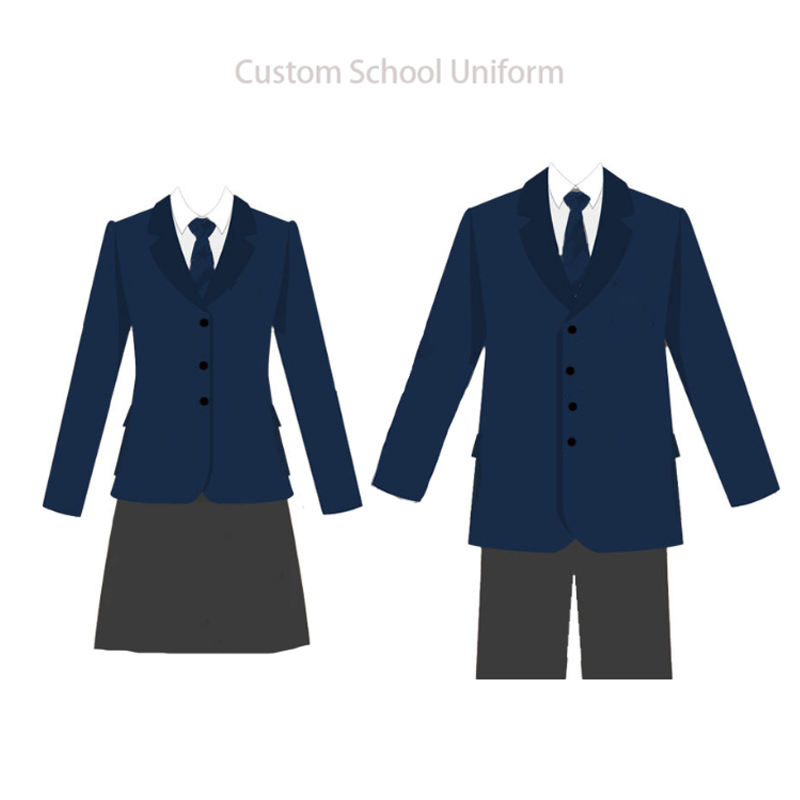Title: The Evolution and Significance of School Uniforms: A Comprehensive Study on Western-Style Suit Uniform
School uniforms have been a topic of discussion for decades. The purpose of this study is to understand the evolution and significance of school uniforms, specifically focusing on Western-style suit uniform. This type of uniform has become increasingly popular in recent years and has gained recognition from various educational institutions. The study aims to analyze the benefits of wearing such uniforms, including improved academic performance and reduced peer pressure. Additionally, the study will explore the cultural and historical background of Western-style suit uniform. It will also examine the challenges faced by schools in implementing and enforcing uniform policies. Overall, this comprehensive study sheds light on the evolution and significance of school uniforms, particularly with regards to Western-style suit uniform. It highlights the potential benefits that such uniforms can bring to students and educators alike, while also providing valuable insights into the complexities associated with implementing uniform policies.
Introduction
School uniforms have been a long-standing tradition in many educational institutions around the world. They serve various purposes, including promoting unity among students, reducing social comparison, and minimizing distractions in the classroom. One type of uniform that has gained popularity in recent years is the western-style suit, which combines the formal look of a suit with the comfort and versatility of a school uniform. This article will explore the history, design, and cultural significance of western-style suit uniforms, as well as their impact on education and society.
Historical Evolution of School Uniforms

The concept of school uniforms can be traced back to ancient civilizations, where clothing was often a symbol of rank or status. In the early modern period, school uniforms began to appear in Europe and America, primarily as a way to enforce discipline and reduce social inequality. However, they were not until the mid-20th century that school uniforms became widely adopted as a standard practice.
During this time, schools began to experiment with different styles and designs of uniforms, including traditional uniforms such as pinafores and caps, as well as more modern takes like pleated skirts and collared shirts. It was not until the late 1960s that the western-style suit uniform emerged as a popular option for school attire. This was due to its sleek and professional appearance, which appealed to parents who wanted their children to make a good impression on teachers and classmates.
Design and Characteristics of Western-Style Suit Uniforms
The western-style suit uniform typically consists of a white shirt, dark blue pants or skirt, a tie, and black shoes. The shirt is usually tucked in at the waist, while the pants or skirt are worn without a belt. The tie is often brightly colored or patterned to add visual interest, and the shoes are usually black or brown leather.
One of the main advantages of western-style suit uniforms is their versatility. Unlike some other types of uniforms, which may only be suitable for certain seasons or activities (e.g. field hockey jerseys), western-style suits can be worn year-round without looking out of place. This makes them an ideal choice for schools with diverse student bodies or for those located in colder climates.

Cultural Significance of Western-Style Suit Uniforms
The rise in popularity of western-style suit uniforms can be attributed to several cultural factors. First and foremost, there is a strong association between formal attire and professionalism in Western culture. By wearing a western-style suit uniform, students are expected to present themselves in a serious and respectful manner, which can help to foster positive relationships with teachers and peers.
In addition, the trend towards individualism and self-expression in many Western societies has led to a renewed appreciation for traditional forms of dress. Many parents view western-style suit uniforms as a way to instill discipline and structure in their children's lives while also allowing them to express their personal style within reasonable limits.
Impact of Western-Style Suit Uniforms on Education and Society
The use of western-style suit uniforms in schools has had both positive and negative effects on education and society. On the one hand, uniforms can help to promote a sense of belonging among students and prevent social comparisons based on clothing choices. This can lead to greater academic success and reduced bullying incidents.

On the other hand, some argue that uniforms stifle individuality and creativity among students, making it difficult for them to express themselves through their clothes. Additionally, there are concerns about the environmental impact of producing large quantities of uniform clothing every year.
Conclusion
Overall, while there are valid arguments both for and against the use of western-style suit uniforms in schools, it is clear that they have become an important part of many educational institutions' dress codes. As attitudes towards fashion and personal expression continue to evolve, it will be interesting to see how these uniforms adapt and change over time.
Articles related to the knowledge points of this article:
Title: The Art of Tying a Tie: A Comprehensive Guide for the Modern Man
Title: The Art of Tying a Tie: A Comprehensive Guide
Womens Short-Length羽绒服,时尚与保暖的完美结合
Womens Down Vest: A Fashion Staple for Winter
Title: The Perfect Tie to Match Your Wedding Dress: A Comprehensive Guide



